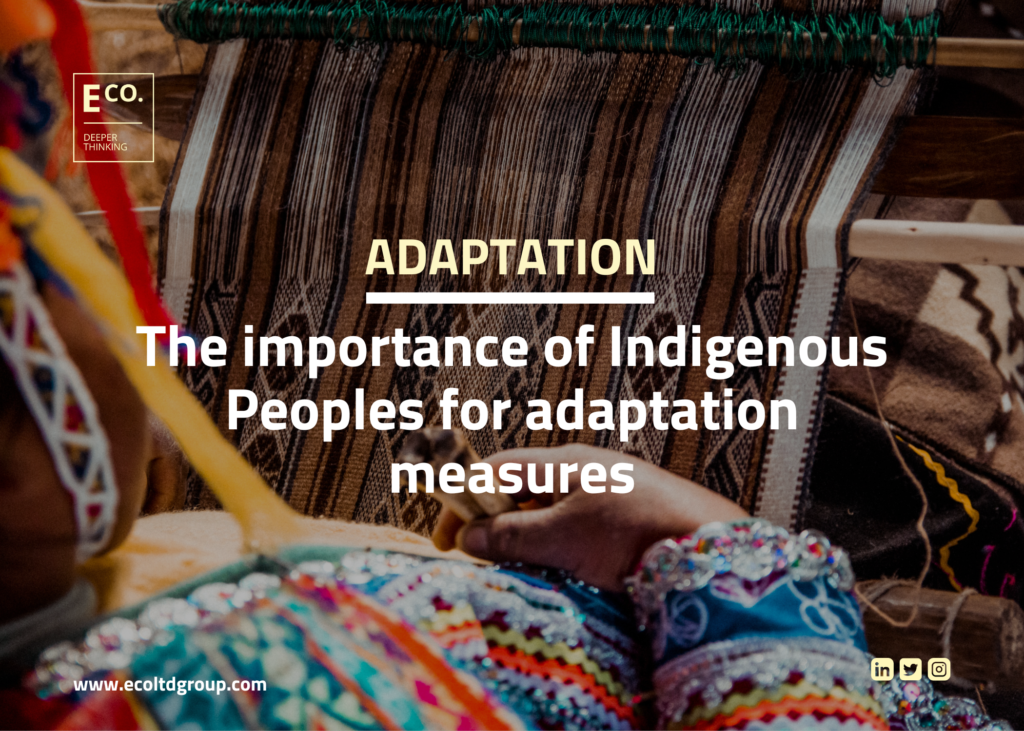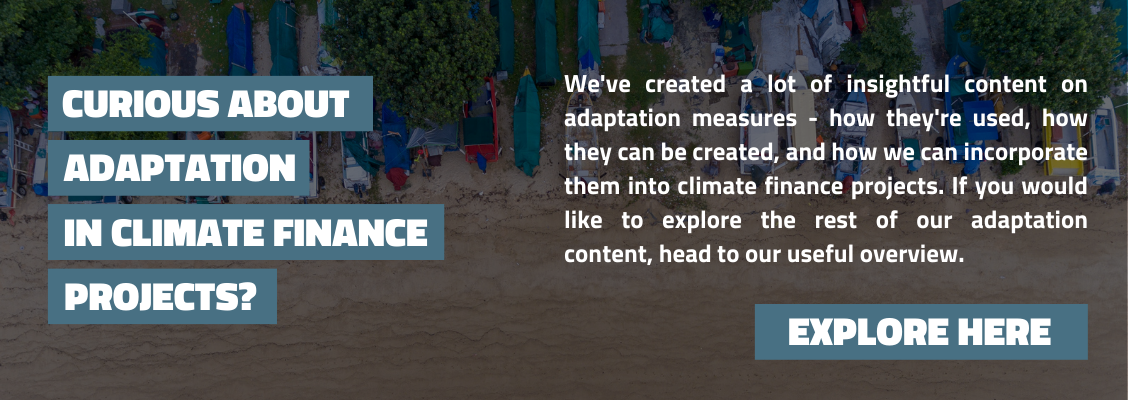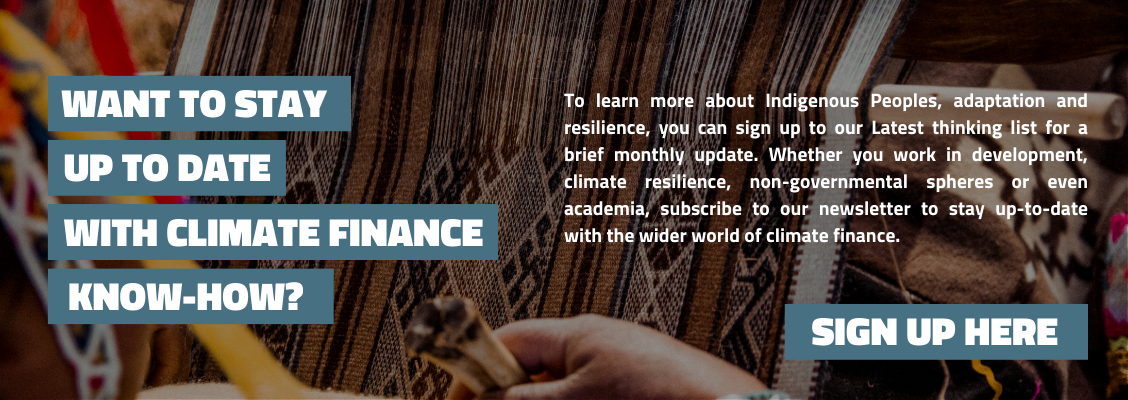The importance of Indigenous Peoples for adaptation measures
14 June 2023, Category: All insights, News, Tags: adaptation, climate change, climate finance, indigenous, indigenous peoples, project design

By Jack Cribb
Indigenous Peoples make up 15% of the world’s extreme poor. They also represent only 5% of the global population. Despite this, they protect 80% of the world’s remaining biodiversity [1]. According to the UNHCR, more than 20% of the carbon stored in forests globally lies within land managed by indigenous Peoples. These groups protect these vital areas, ensuring continued carbon sequestration [2].
However, even though Indigenous Peoples represent an impressive and longstanding commitment to effective environmental stewardship, their knowledge, experience, and passion remain largely untapped and unacknowledged.
For countless years, indigenous peoples have been implementing both effective and affordable strategies that address climate and environmental issues, such as deforestation and biodiversity loss. Going forward, those in the development sector and beyond need to recognise the multifaceted role of indigenous knowledge when it comes to fighting against climate change and stewarding our natural environment.
In this article, we will be answering several questions:
- What is the importance of Indigenous Peoples in ensuring climate resilience?
- How can local knowledge be used practically?
- Why should adaptation measures include considerations for Indigenous Peoples?
- How can Indigenous Peoples be centred within adaptation practices?
The importance of Indigenous Peoples and their actions
Indigenous Peoples, in most cases, have operated within the same areas for hundreds, if not thousands, of years. Their livelihoods are intricately linked to the land they live on and cultivate. But not only do they work to protect natural resources and ecosystems–they also promote practices that have a great capacity to capture and store carbon, protect biodiversity, and represent many years of rich and diverse cultural development. Indigenous Peoples also have the potential to contribute to culturally sensitive rural development and the achievement of SDGs.
It is of imperative importance that national and international governments work to protect the territorial and cultural rights of Indigenous Peoples around the world, ensuring that their cultures and livelihoods are protected for years to come.
Using local knowledge to improve climate outcomes
In countless scenarios across the globe, it is Indigenous Peoples and local communities that bear the brunt of our climate emergencies, from extreme weather to biodiversity loss to food insecurity. As these groups tend to have a close relationship and dependency upon natural environments and the resources therein, they are particularly vulnerable to climate change.
For example, in Vanuatu, in the wake of extreme weather events, the utilisation of traditional building techniques proved to be a key advantage, securing gains in disaster risk reduction [3]. It was found that nakamals, a type of building, were much safer and stronger when built using local materials and knowledge. These served as evacuation centres during Cyclone Pam in 2015.
Similarly, in areas in Africa, such as Burkina Faso, Mali, and the Tigray province of Ethiopia, a water harvesting technique that originated in the Sahel, called zai pits or tassa, is being used to restore degraded drylands. [4] In Southern Bolivia, around Lake Titicaca, a type of raised field agriculture known as waru waru is employed to maintain high crop yields while also preventing damage from any flooding [5]. These examples of climate-smart agriculture, and the utilisation of indigenous knowledge for adaptation, are helping to increase both soil fertility and crop yields.
More often than not, adaptation measures are built upon nature-based solutions, many of which are developed through the use of traditional knowledge. These can effectively contribute to adaptation strategies at the local, national, and global levels, where indigenous knowledge can inform policy decisions and adaptation frameworks. For example, in the IPCC’s AR6 Summary for Policymakers, it reads in C.2.3:
Adaptation for natural forests43 includes conservation, protection and restoration measures. In managed forests43, adaptation options include sustainable forest management, diversifying and adjusting tree species compositions to build resilience, and managing increased risks from pests and diseases and wildfires… Cooperation, and inclusive decision making, with local communities and Indigenous Peoples, as well as recognition of inherent rights of Indigenous Peoples, is integral to successful forest adaptation in many areas. (high confidence). [6]
Why should adaptation measures consider indigenous Peoples?
It is not only adaptation measures that need to take into account indigenous knowledge. The relationship between these measures and the rights of Indigenous Peoples needs to be respectful and work in either direction.
What we mean by this is that, while adaptation measures will benefit from the inclusion of indigenous knowledge, experience, and capacity, they also must work in favour of those communities, protecting and supporting them. This thinking is the result of three key insights:
- The majority of Indigenous Peoples live in structurally vulnerable conditions. They operate in areas far from access to services such as healthcare, education, and water.
- Indigenous Peoples each have their own cultural contexts. Adaptation measures must account for the separate contexts that accompany these groups. Any measures implemented by a representative party must integrate these contexts within any academic or practical work.
- Climate change and its effects will hit Indigenous communities the hardest. There is a pronounced vulnerability for many of these groups. Climate change for them is a matter of life and death. Recognising this vulnerability should mean that adaptation measures and the finance supporting them are quicker to access and more readily available.
It has regularly been found that Indigenous Peoples are the best guardians of their environments. For example, in a 2021 report published by the FAO, found that ‘Indigenous and Tribal Peoples in Latin America and the Caribbean are the best guardians of their forests when compared to those responsible for the region´s other forests.’ (Kaimowitz, et al.). In fact, in terms of Latin America and the Amazonia, 45% of the intact forests in the Amazon Basin are found within indigenous territories [7].
E Co. bites: Why are Indigenous Peoples so important for climate action?
In this E Co. bite, Principal consultant Ignacia Holmes talks about why utilising the knowledge and experience of Indigenous Peoples is vital.
Watch more of our E Co. bites here.
The positioning of indigenous knowledge in adaptation practices
In Article 7.5 of the Paris Agreement, it recognises that adaptation should:
Follow a country-driven, gender-responsive, participatory and fully transparent approach, taking into consideration vulnerable groups, communities and ecosystems, and should be based on and guided by the best available science and, as appropriate, traditional knowledge, knowledge of indigenous peoples and local knowledge systems [8]
It is increasingly recognised that conservation as an act can be improved through an increased focus on governance and solutions that reinforce the rights and roles of Indigenous Peoples, be that in scenarios where biodiversity hotspots need to be protected or where ecosystems need to be restored (amongst many others) [9]. Similar findings have advocated for approaches based on five pillars [10]:
- Recognition and strengthening of collective territorial rights.
- Compensation for environmental services.
- Facilitating community forest management.
- Revitalization of ancestral knowledge.
- Strengthening of grassroots organizations and mechanisms for territorial governance.
When it comes to applicable indigenous practices, clusters of knowledge exist all over the world, with many residing in tropical rural areas, subtropics, and drylands [11]. Development practitioners must account for these knowledge banks in the research and development of projects and programmes.
Similarly, practitioners must utilise adaptation measures that make sense contextually. For example, in many scenarios that include components pertinent to indigenous communities and their rights, ecosystem-based adaptation (EbA) is the main thrust of the project. This is usually because EbA takes place in situ, relying upon the capacities, knowledge, and techniques of local actors–such as local pastoralism being enacted in drylands or areas of uncertain rainfall levels.
Best practices for including indigenous and traditional knowledge
Indigenous and traditional knowledge (ITK) can be included in adaptation projects and programmes by utilising these methods for mobilisation:
- Work to recognise the ownership and diversity of ITK;
- Ensure that the utilisation, validation, and sharing of ITK is done by the Indigenous Peoples it originates from.
- Any research undertaken must be community-led, rather than community-based;
- Account for the longer time frames that may be required when collaborating with indigenous, tribal, and local communities;
- Within any project design, community engagement must be included as a non-negotiable requirement, as well as a precondition for funding.
Additionally, development practitioners can use these tools to aid in the inclusion of ITK and account for the needs and voices of Indigenous Peoples:
- Knowledge exchange platforms that facilitate communication between stakeholders;
- Participatory rural appraisal tools, such as assessment and evaluation, and the participatory mapping and demarcation of indigenous and protected areas (with a distinct focus on recognising indigenous sovereignty).
Indigenous-inclusive adaptation should not be viewed simply as a response to climate change, but also as part of the wider state of responses that actively work to improve the livelihoods of these communities. In many development scenarios, Indigenous Peoples are seen as ‘passive’, despite the fact they are continuously asserting their rights. When used in tandem with non-traditional or contemporary measures, traditional cultural and land tenure practices make way for present and future adaptation measures to be increasingly effective, and meet current socio-ecological and cultural responsibilities.
Going forward, there needs to be a new relationship between development practices, practitioners, and indigenous communities. This new relationship requires the adequate allocation of resources that not only protect but revitalise, the wealth of knowledge being harboured.
Adaptation practitioners will most likely find that by utilising material and immaterial cultural resources, climate resilience projects based around ecosystem adaptation, forest management, and biodiversity conservation, can be far more successful.
Keep up-to-date with climate finance know-how
Looking for insight into climate finance? Look no further
Get in touch with our climate finance consultants to discuss a project you’re working on and create successful, fit-for-purpose projects, now and in the future. Email us at: amy@ecoltdgroup.com or find us at the following:
Twitter: @ecoltdnews
LinkedIn: E Co.
Instagram: @ecoltdnews
References
- https://www.statista.com/chart/27805/indigenous-communities-protect-biodiversity/
- https://reliefweb.int/report/world/indigenous-peoples-knowledge-and-climate-adaptation-9-august-2020
- https://www.unesco.org/en/articles/vanuatus-traditional-architecture-makes-community-more-resilient-face-climate-change-related
- https://www.fao.org/3/y4690e/y4690e.pdf, pg. 77
- https://assets.publishing.service.gov.uk/media/57a08a5d40f0b64974000574/120625_ENV_AdaMouEnv_BRIEF2.pdf
- https://www.ipcc.ch/report/ar6/wg2/downloads/report/IPCC_AR6_WGII_SummaryForPolicymakers.pdf
- https://www.fao.org/news/story/en/item/1391139/icode/#:~:text=Indigenous%20territories%20emit%20less%20carbon,2%20times%20less%20in%20Colombia
- https://unfccc.int/sites/default/files/english_paris_agreement.pdf
- https://www.iucn.org/sites/default/files/2022-06/es-2021-12625.pdf
- https://www.fao.org/3/cb2953en/cb2953en.pdf
- https://iopscience.iop.org/article/10.1088/1748-9326/abb330#erlabb330s5


Join the conversation by posting a comment below. You can either use your social account, by clicking on the corresponding icons or simply fill in the form below. All comments are moderated.